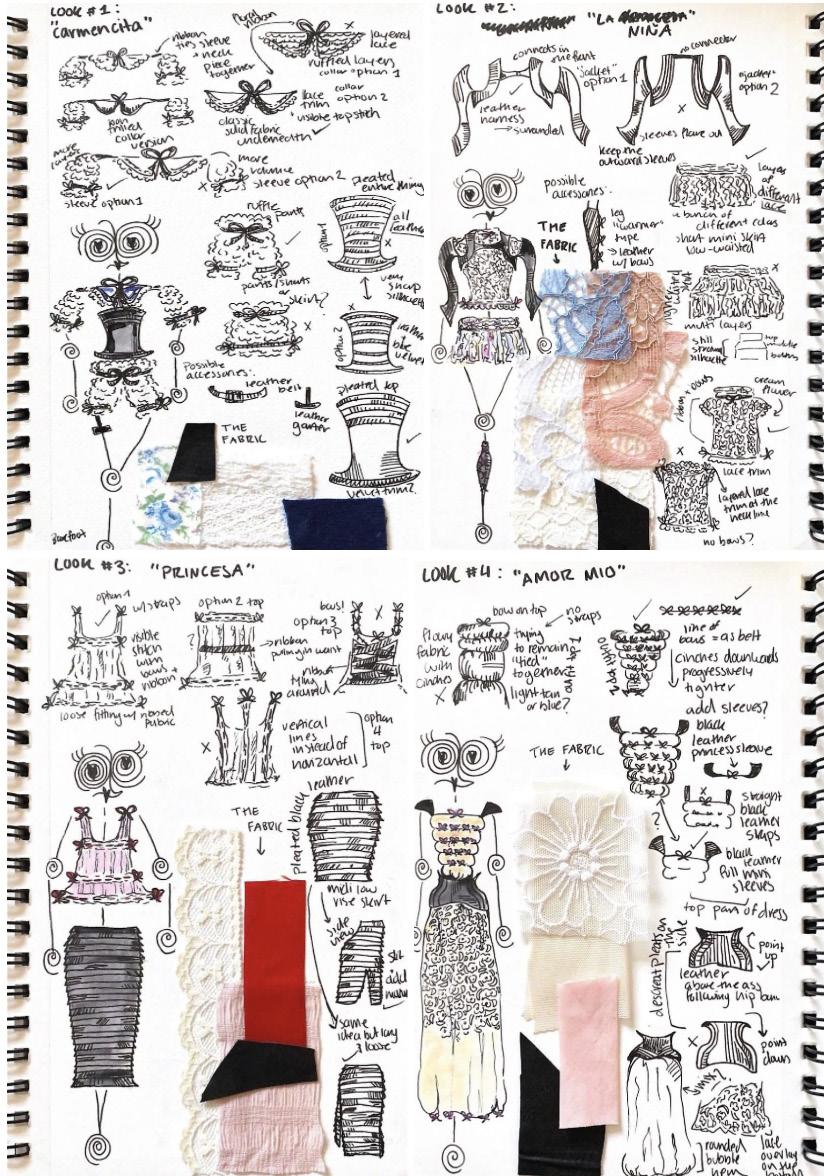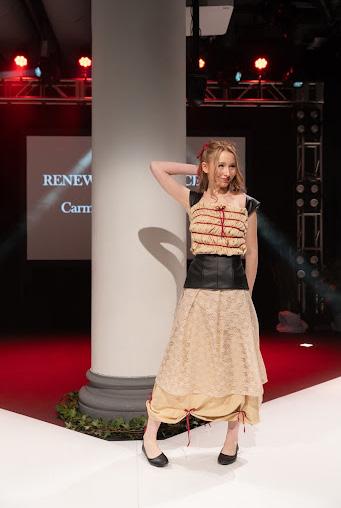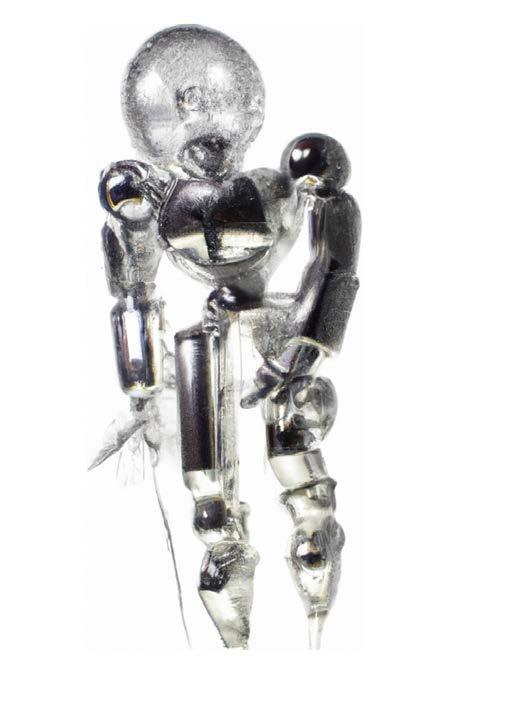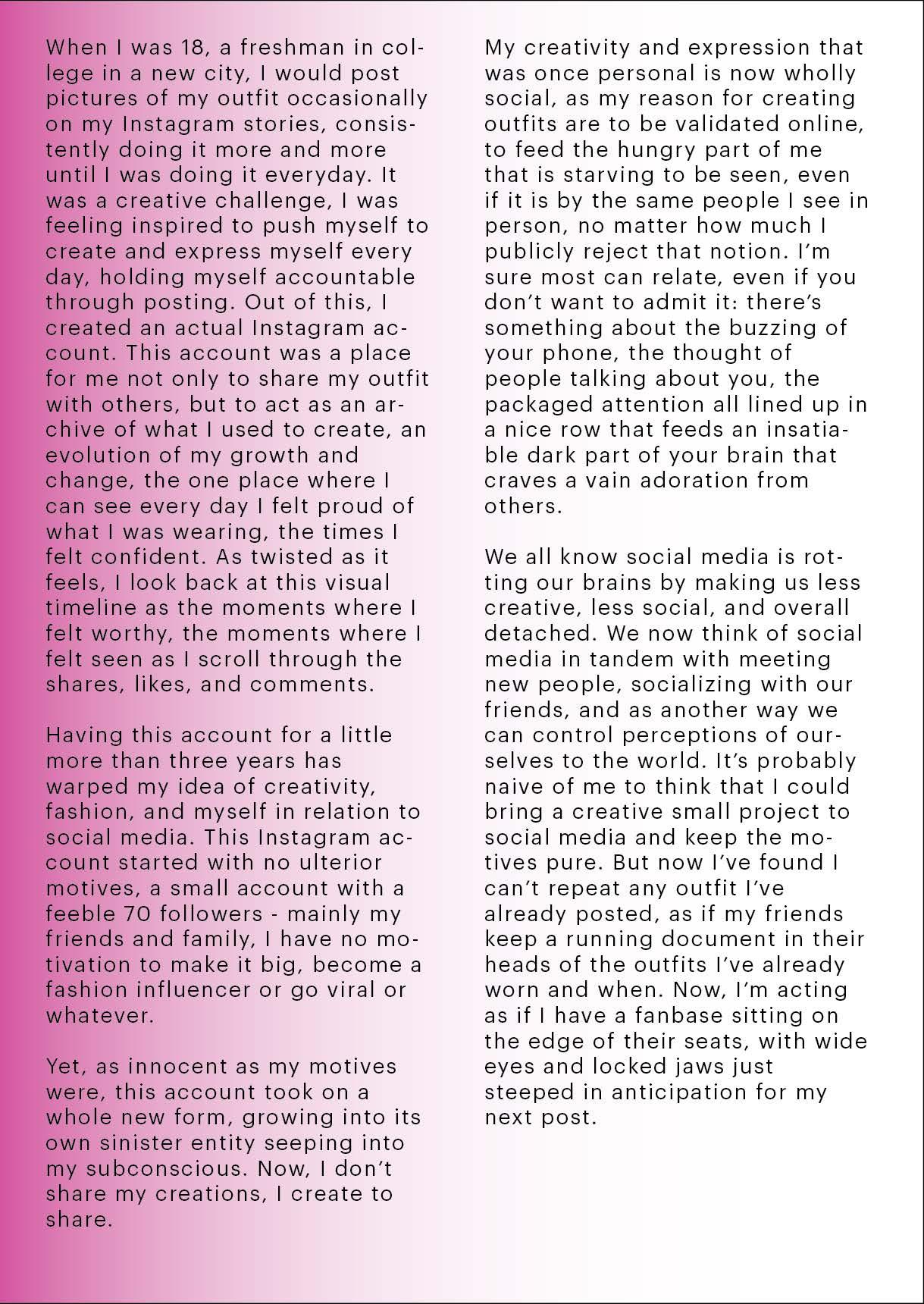
3 minute read
CARMEN LOPEZFERNANDEZ
from VisMajor Spring 23
by NYU Vismajor
Carmen, who showed of her collection called Renewal of Innocence at Renewal: The Gallatin Fashion Show, is studying at Gallatin, concentrating in Fashion Environmental Science and Business and minoring in Creative Writing. She started fashion design in 2021, her junior year in high school. Her design process starts with contrasting ideas, forming silhouettes, and focusing on how to entangle them together.
Carmen made her ofcial frst step in fashion at the Gallatin Fashion Show, showcasing her frst collection called the Renewal of Innocence. All of her pieces showcase pureness and loveliness. The shirring, complex, industrial ribbon and lace used in the collection express a dreamy sensibility and clarity. Also, the dark leather she conveys her message in two contrasting relationships, expressing maturity and growth as opposed to pureness and innocence.
Advertisement
She said that fashion can be a lot of disappointment. Rather than accepting all parts of the criticism, she says she listens to those that help her to grow further as a stepping stone to be
“Amor Mio” from the Renewal of Innocence collection at the Gallatin Fashion Show, modeled by Taylor Fuchs (©Myaskovsky: Courtesy of NYU Photo Bureau)

“Princesa” from the Renewal of Innocence collection at the Gallatin Fashion Show, modeled Sami Bates (©Myaskovsky: Courtesy of NYU Photo Bureau)

“La Niña” from the Renewal of Innocence collection at the Gallatin Fashion Show, modeled by Christine Marabella (©Myaskovsky: Courtesy of NYU Photo Bureau)

“Carmencita” from the Renewal of Innocence collection at the Gallatin Fashion Show, modeled by Mamaati Mulahi (©Myaskovsky: Courtesy of NYU Photo Bureau) sketches for the Renewal of Innocence collection by Carmen Lopez-Fernandez


Cyberpunk developed as a subgenre of science fction around the 1960s as it refected the time’s concerns for humanity’s fate as technology became more complex and powerful. The 20th century was a time of worldwide political instability that inspired artistic–primarily literary–explorations of possible dystopian futures of society. The imagination and visualization of these dystopias varied by era, infuenced by the unique challenges each faced. For example, authoritarian regimes in the early 20th century refected the fear of technology stripping humans of their autonomy. The second half of the 20th century saw a growth in right-wing politics that supported a free market and worsening economic disparities—this time also led to rapid technological innovations, with a special emphasis on communication technology like the computer and the internet. The increased possibilities of obtaining information from people created a fear of surveillance, control, and technology becoming impossibly intertwined with humanity. With a foundation in cybernetics and punk culture, Cyberpunk inherited punk ideologies of nonconformity and self-consciousness utilized to explore these fears by imagining how people and machines interact in a post-capitalistic, hyper-technological future.

Cyberpunk is best known for its visual aesthetic that has been developed across different visual media such as flm, television, anime, and video games. The genre’s iconic visuals are dominated by neon lights, pervasive technology, and large-scale buildings that juxtapose the chaotic streets of the future. In these settings, the body and fashion become a tool that extends the immersive experience of Cyberpunk by revealing the personal manifestations of the social context of its characters and environment. Clothing allows characters to display their social marginalization as well as their increasing proximity to technology and body modifcations.
Cyberpunk fashion is not uniform across media, evolving and adapting to the period of creation and worldbuilding of the piece of which it is part. However, it generally combines nostalgia and the conception of future innovations in clothing. It is also infuenced by military attire, showing a juxtaposition between eccentricity and utilitarian fashion. Popular pieces include military boots, knee pads, bodysuits, leather jackets, long coats, body armor, light-up suits, and robotic augmentations. At the more futuristic end of the spectrum is the costume design of Tron (1982) by Elois
Jenssen and Rosanna Norton. The movie follows the crossover into a computer system for which Jenssen and Norton created skin-tight suits with vests and protective gear that lit up in neon colors that represented the physical form of computer programs. The costume design of the video game Cyberpunk 2077 focused on the aspect of gear, body augmentations, and the utilitarian fashion that is more commonly associated with Cyberpunk. Amongst the designers that have been infuenced or directly worked on Cyberpunk fashion is French designer, Jean Paul Gaultier. As the costume designer of the flm “The Fifth Element,” Gaultier created a futuristic aesthetic that leaned toward the unconventional and challenged social norms, infuenced by punk, high-end, and utilitarian fashion. Gaultier’s The Fifth Element’s 23rd-century looks became immediate icons within the genre as well as the fashion industry as a whole. These include the humanoid Leeloo’s white bandage dress and orange hair and Ruby Rhod’s leopard catsuit. Prior to the release of the flm, Gaultier released his Fall/Winter 1995 “Cyber” collection. The collection adopted an apocalyptic, dystopian look that resembled the trilogy Mad Max’s industrial aesthetic while portraying the importance of technology. The most recognizable looks were dotpatterned jumpsuits with the outline of bodies wearing that resembled an electronic circuit.

Clothing and fashion refect the individual and collective responses to economic, political, and ideological changes in society. These changes not only infuence the consumer choices of individuals but also the creative process of designers who shape the way trends develop and change. By employing the rebellious affordance of punk, Cyberpunk defes social codes and barriers by combining pieces and materials popular in punk fashion and technological elements.













